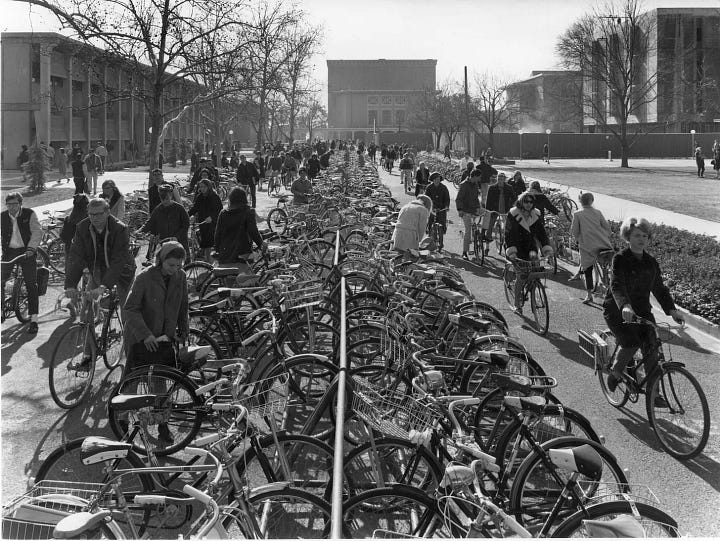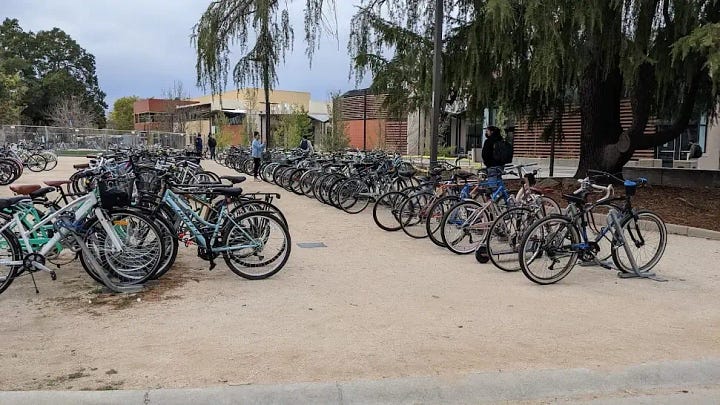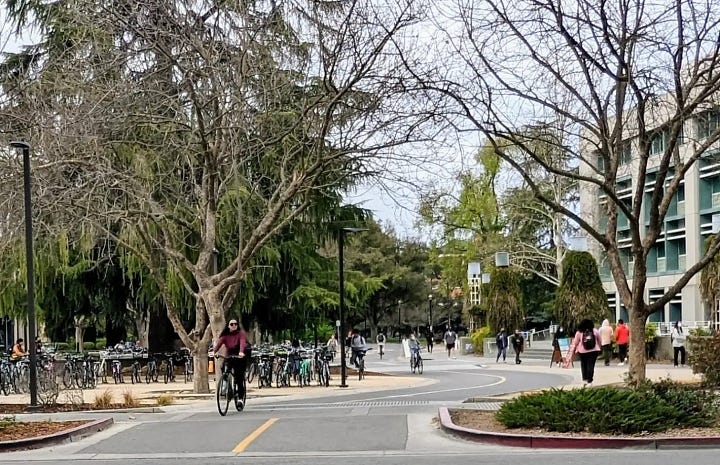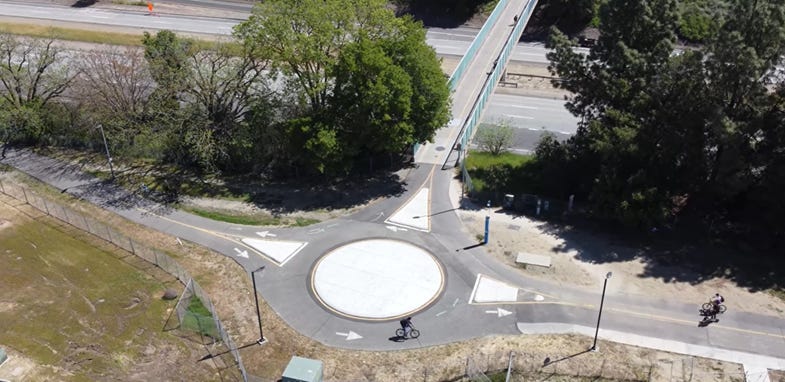Davis, The American Amsterdam: A Pioneering Cycling Town In Northern California
History | Cycling Cities | Davis, California
If only there were a street-side herring seller, cycling in Davis, California, might feel like pedaling through a Dutch town. With its wide bike lanes and fresh, breathable air, this small American town is a true cycling oasis. But how did it transform into a two-wheeled paradise in a country dominated by cars, congestion, and pollution? Today, we take you on a cycle ride through Davis, to learn how it defied the odds and the lessons it offers for building bike-friendly cities across North America.
Know of any other unlikely cycling gems around the world? Let us know in the comments!
“Unlike other American cities, Davis is a place where ordinary people can and will ride bikes. Bicyclists are as common as birds, bicycling is a way of life, people are as comfortable on a bike as they are in their car or on their feet” (Buehler & Handy, 2007)
Imagine bucolic cycling lanes weaving through meadows and quiet streets, a peaceful atmosphere, and warm weather year-round. Welcome to the U.S.'s very own Dutch-style cycling city, where the bike is an integral part of the community fabric. Ridership here, in Davis, is higher than anywhere else in the United States. With a modal share for bikes exceeding 20%, the small Californian City is only about 5–10% behind some of the world’s most renowned bicycle cities This is especially high considering that most North American cities do not even reach 2% (Reid, 2015). With a cycling tradition now half a century old, the city features more than 160 km of bike paths and 25 bike-only bridges and tunnels. A little-known fact is that it was the first city in the USA to legislate and implement standardized bike lanes back in the 1960s. For more than 50 years, the city and its university have worked together to foster bicycle-friendly development. By comparison, San Francisco didn’t get its first protected bike lane until 2010, and Chicago until 2016 (Flax, 2017).

Most North American suburbs, today, remain overwhelmingly designed for the convenience of car drivers. Side streets are wider than necessary to accommodate parking, and often include random dead ends that deter walking between destinations. Wide lanes have been shown to encourage car drivers to exceed speed limits endangering themselves and other road users . Davis, with its design that prioritizes safety, sustainability, and community well-being, has become a pioneering example of thoughtful urban planning, earning its reputation as the Cycling Capital of the United States.
All well-earned logo
When you know about Davis' history of cycling, it’s no surprise that the city features a bicycle on its logo. Even back in 1966, as captured in this black and white photo by renowned photographer Ansel Adams, bicycles were a well-respected mode of transportation at the University of California, Davis (UC Davis) campus. A busy college, filled with cyclists and overloaded bike parking stands, with students riding in all directions.


Behind this cycling trend was the campus’ bicycle-loving chancellor, Emil Mrak, and his plan to increase the student population from 2,000 to 10,000. As new students and staff were going to move to the town, Mrak had to rethink the mobility logistics of the area. If the city could not accommodate an additional 8,000 cars, surely, it would welcome an additional 8,000 bicycles. Convinced, the chancellor ordered architects to develop a cycling-friendly campus and invited future students to take ownership of cycling (Reid, 2015). It didn’t take long for the university’s tree-lined, car-free campus, filled with lanes, to start bustling with young people on bikes (Flex, 2017).
From UC Davis University Campus to the Netherlands and Back

Cycling was already popular among the student community in the 1960s, but at the city level, there was no infrastructure in place to accommodate this growing trend. And despite being on separate continents, Dutch cycling culture crossed the Atlantic to reshape the mobility landscape of a small Californian city.


Upon returning from Amsterdam, Eve and Frank Child, a couple of faculty members from UC Davis, decided to advocate for Chancellor Mrak's vision at the city level. Their experience of riding bicycles with their children in a two-wheels paradise convinced them to sell their car and form an action group, known as the Citizen Bicycle Study Group (CBSG), where “people met over their kitchen tables and got mad and expressed determination that things would change” (Flex, 2017). The group, which petitioned city officials to create dedicated bike lanes similar to the Dutch ones, sent a letter to the local newspaper in 1963, warning of the consequences of giving in to motorcars, and including the biblical barb: “Where the leaders have no vision, the people perish” (Reid, 2015; Reid, 2017). However, their plan, which proposed a series of dedicated bike lanes, was rejected by the city. The group decided to take the issue to the voters, and showed unconditional support to two bike lane advocates, and council candidates Norm Woodbury and Maynard Skinner. Following the election of both candidates to the city council in 1966, Governor Ronald Reagan signed legislation granting UScities the right to establish dedicated bike lanes on local streets (Flex, 2017).
By summer 1967, the small Californian city of Davis inaugurated its first ever dedicated cycle lane, normal for the Netherlands but a first for the U.S. This innovation was very progressive, back at a time when the rest of the country was building for cars. Over the past 30 years, citizen activists, the Davis Public Works Department, and a highly supportive City Council came together to create the extensive network that Davis is celebrated for today (Berman, 2007). The earliest version of the city’s bicycling maps, in the 1970s read "Davis: The Bicycle Capital of America (Reid, 2017). A decade later, the cycling mode share in Davis was reaching a staggering 30%. And unsurprisingly, today, the bicycle share is the highest among the student community, at 50% (Reid, 2015).
A national platinum example
Today, the UC Davis campus, in particular, is considered a gold standard for promoting safe and accessible cycling on university grounds (C&T, 2024).
“Today in Davis, if you squint, you could be in the Netherlands: people get around on bikes. School kids. Students. Professors. Bank managers (...) Cycling in Davis is not cultish—it’s ordinary, no special clothing required.” (Reid, 2017:68)
This earned the city its first ever Platinum Level Bicycle Friendly Community award by The League of American Bicyclists in 2005, the highest award possible (City of Davis, 2024). The award, which gives strict consideration to elements such as bike infrastructure, efforts in adult and youth bike education, encouragement through events like Bike to Workday and equity in enforcement, has remained in the hands of Davis ever since (ibid.).
Cycling to school made easy
Davis is particularly active with initiatives to promote cycling among children, with a highlight being the annual Bike and Roll to School Day held in May, designated as "Bike Month." These events help raise awareness about safer routes for biking and walking, promote physical activity, reduce traffic congestion, and foster environmental responsibility. Schools within the Davis Joint Unified School District (DJUSD) participate in contests such as the Golden Wheel for the highest percentage of bicycles on racks and the Most Active4me Scans for tracking bike usage, with winners receiving prizes like popsicle parties.
The city’s official website also provides a downloadable Routes to School Maps, for children to identify the best, safest cycling itinerary. For each school, the best cycling routes are highlighted for students, along with tips on staying safe on a bike, navigating traffic rules, and more (City of Davis, 2020).
A network excellence, hints of Dutch influence
Davis’ cycling ridership is facilitated by a safe and connected cycling network. To make cycling viable, infrastructure must prioritize safety and convenience. With features like peripheral bike roundabouts and a network of greenways connected by trails, the city offers seamless and enjoyable cycling for residents and visitors alike. Davis also includes an impressive network of tunnels and overpasses, allowing cyclists to stay separate from car traffic as much as possible. This infrastructure makes cycling safer and more appealing, setting a standard for other cities (BQ with Mk, 2023).
In 2015, one of the city’s most innovative infrastructure projects was introduced: the first-ever 4-way protected intersection in the U.S. These ensure greater safety by making both cyclists and pedestrians more visible to drivers (Stromberg, 2015).

Is infrastructure the only factor at stake?
Finally, it should be noted how the widespread, dedicated bike infrastructure, is complemented with side factors which facilitate Davis cycling culture:
First, the city's policies prioritizing bike parking. Just like many cities have parking mandates for cars, Davis has bike parking requirements. Such policies are rare in other U.S. cities but are crucial in Davis to guarantee that cyclists always have a place to park. These regulations ensure the provision of bike parking at any development, whether commercial, residential or office buildings (City of Davis’, 2024).
Second, and often overlooked when considering a city’s cyclability, is that, although accessible by car, it is surprisingly easy to get to Davis without one. The city is well-connected by rail, has a frequent and reliable bus service, and offers excellent train connections for regional travel. What would feel completely ordinary in a Dutch city is exactly what makes Davis stand out from other Californian cities. The moment you step off the train in Davis, you will notice bike parking right by the station, and almost every corner of the city is equipped with dedicated bike parking facilities (C&T, 2024).
Third is the city’s unique street design, with buildings set close to the street, smaller lawns, and trees that provide shade. This creates a comfortable and favourable environment for pedestrians and cyclists, while also narrowing the road for drivers, forcing them to slow down and drive more cautiously. In addition, the city’s compact layout means most destinations are within reasonable biking distance, and Davis’ limited urban sprawl reduces the need for cars. Finally, its mild climate year-round and a young college population only help further boost cycling (ibid.).
To conclude, as U.S. cities look for solutions to reduce congestion, improve public health, and address environmental challenges, the lessons from the pioneering cycling city of Davis offer inspiration. What makes Davis unique is the strength of the local movement, with residents and university students pushing for safer, more bike-friendly infrastructure. The University of Davis played a key role in this transition, serving as a platform for bike enthusiasts and sustainable transportation advocates, whose efforts helped shape local government policies. Could similar grassroots efforts inspire other cities today to make cycling a primary mode of transportation?
Written by Louise Raclet, Researcher at Urban Cycling Institute.
Interested in writing or sponsoring an article? Send us a pitch at media@urbancyclinginstitute.org
Sources:
Berman, D (2007, April) Bicycle Futures. Flatlander. Retrieved from [Information about "BicycleFutures.jpg" on bicycle news articles - Davis - LocalWiki].
Bike Quest with Mike West (BQ & MW) (2023, April 18) We Must Legitimize Cycling! - Inspiration from Davis, CA [Video]. YouTube. Available form [We Must Legitimize Cycling! - Inspiration from Davis, CA].
Buehler, T., & Handy, S. (2007). Fifty years of bicycle policy in Davis, CA. In Paper accepted for presentation at the 2008 Annual Meeting of the Transportation Research Board, Washington, DC.
Climate and Transit (C&T) (2024, July 26). Is it America’s cycling capitol [Video]. YouTube. Available form [Is this America's cycling capitol?].
City of Davis (2020) Bike Map and Suggested Routes to School Maps. [online] Accessible from [Bike Map and Suggested Routes to School Maps | City of Davis, CA].
City of Da
vis (2024) Davis Bike and Pedestrian Infrastructure. [online] Accessible from [Davis Bike and Pedestrian Infrastructure | City of Davis, CA].
City of Davis’ (2024, October 1) Article 40.25A: Bicycle parking standards. online] Accessible from [https://ecode360.com/44652403] [Accessed on 12 December 2024].
Flax, P. (2017, March 8) The Small California City Responsible for America’s First Bike Lane. Outside. Retrieved from [The Small California City Responsible for America's First Bike Lane].
Klayko, B. (2015, August 12). Ever heard of a protected intersection? Davis, California just opened the country’s first—and it works like a charm. Broken Sidewalk. Retrieved from [Ever heard of a protected intersection? Davis, California just opened the country’s first—and it works like a charm | Broken Sidewalk].
Online Archive of California (OAC) (n.d.) Bicycles, Students riding bicycles through bicycle parking area. Most of the bicycles have baskets. All of the females are wearing dresses or skirts. [online] Retrieved from [Bicycles, Students riding bicycles through bicycle parking area. Most of the bicycles have baskets. All of the females are wearing dresses or skirts] [Accessed on 12 December 2024].
Reid, C. (2015, August 3). Davis, California – the American city which fell in love with the bicycle. The Guardian. Retrieved from [Davis, California – the American city which fell in love with the bicycle | Cities | The Guardian].
Reid, C. (2017). Davis: The bicycle capital of America. In Bike boom (pp. 68) . Island Press.
Rosa, R. (2022, March 31) Davis, California: Taking bicycling seriously for 55 years. StreetsBlog Chicago. Retrieved from [Davis, California: Taking bicycling seriously for 55 years - Streetsblog Chicago].
Stromberg, J. (2015, August 12) This California city just built the country’s first protected intersection for bikes. Retrieved from [This California city just built the country’s first protected intersection for bikes | Vox].








